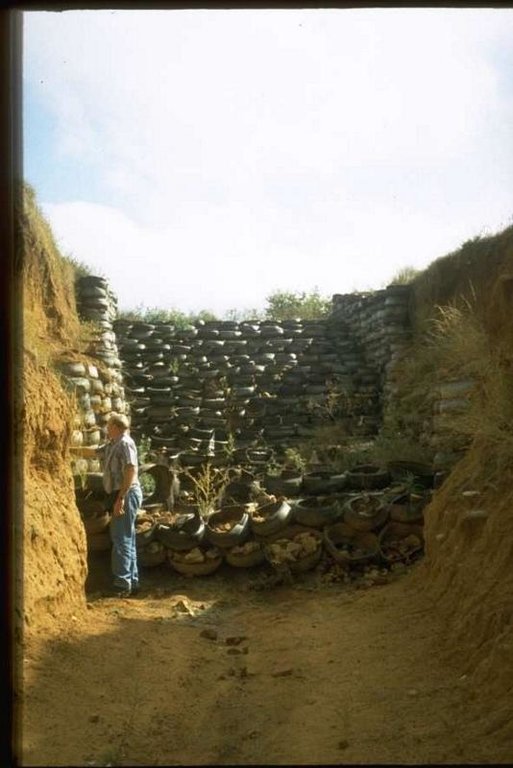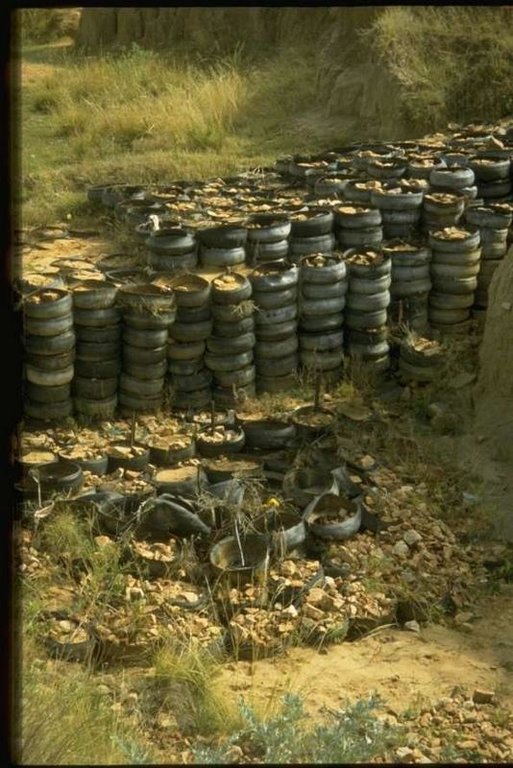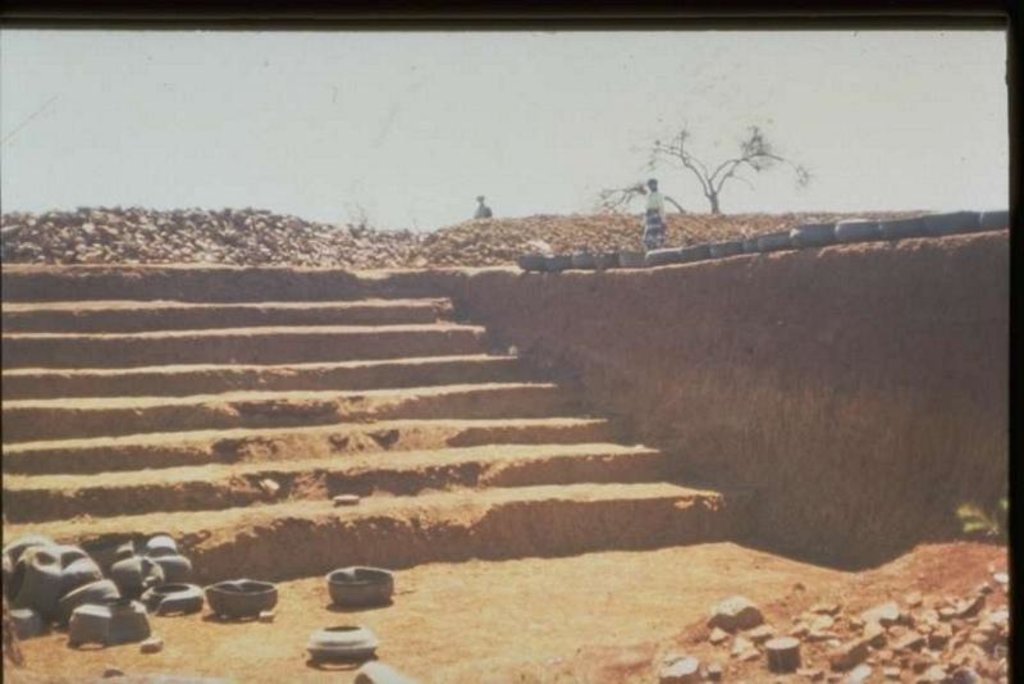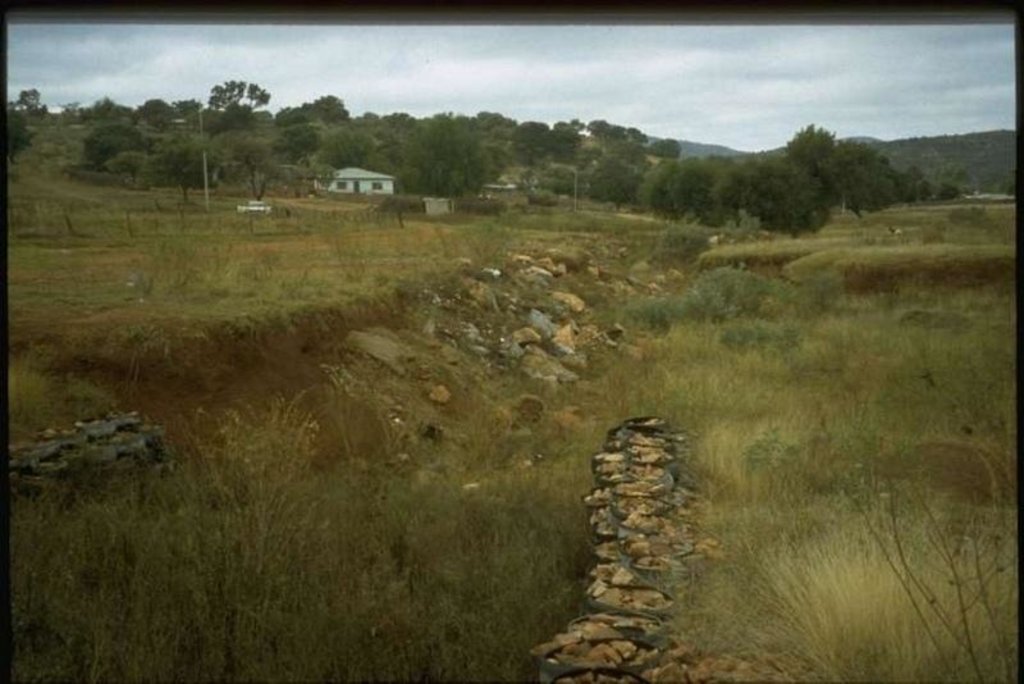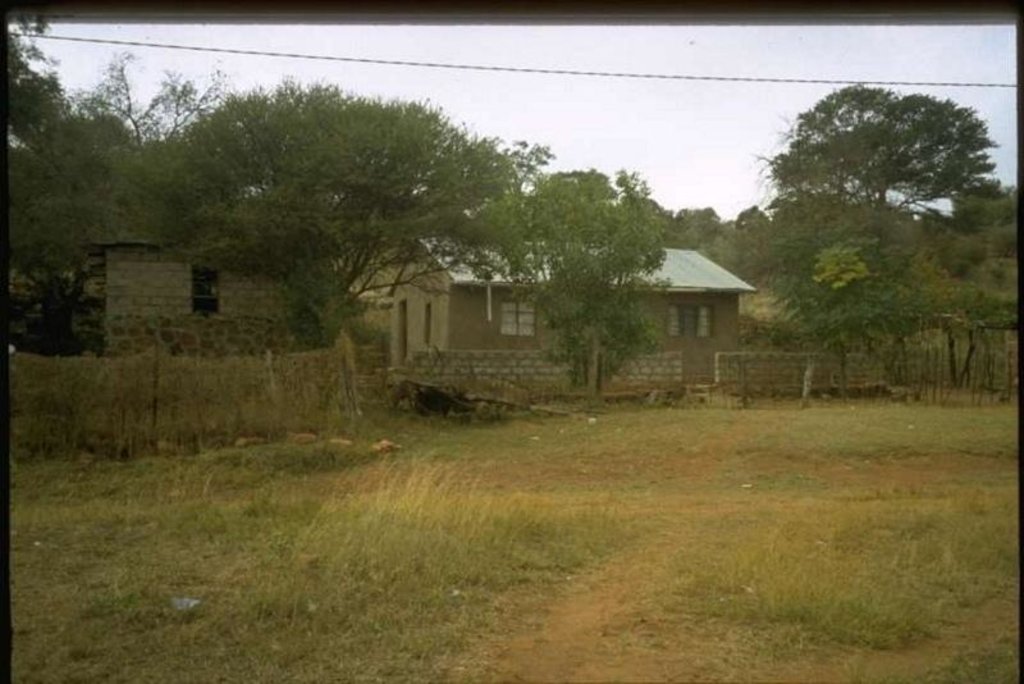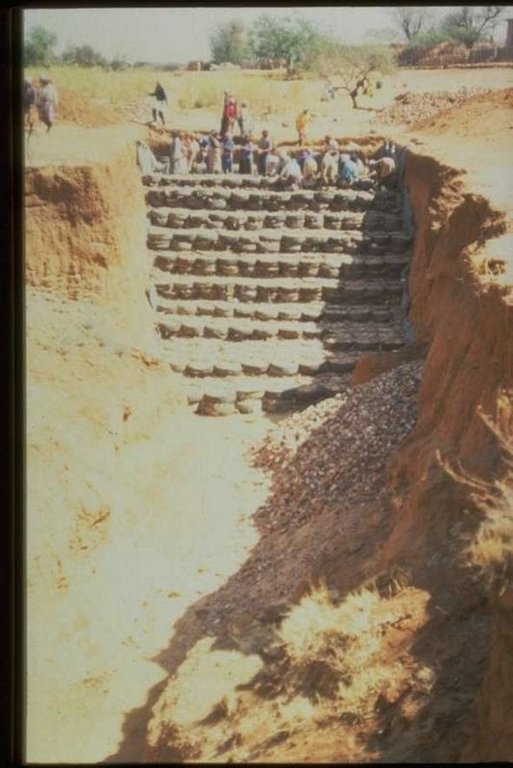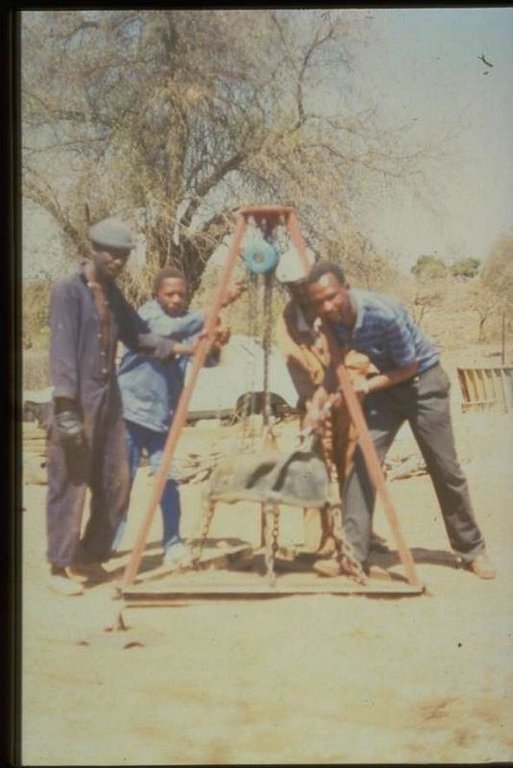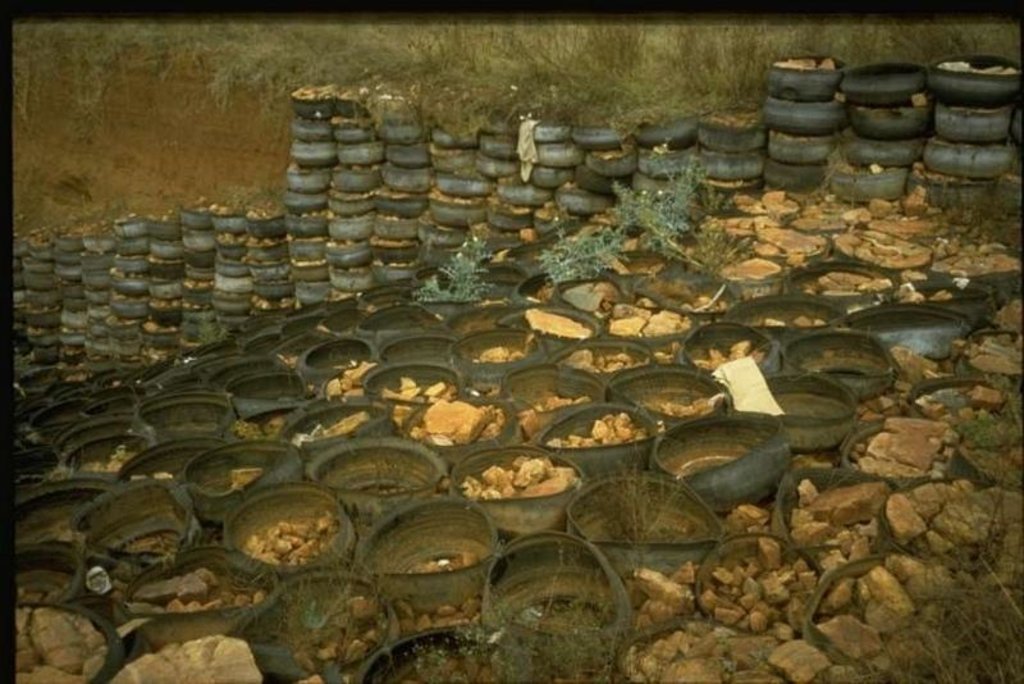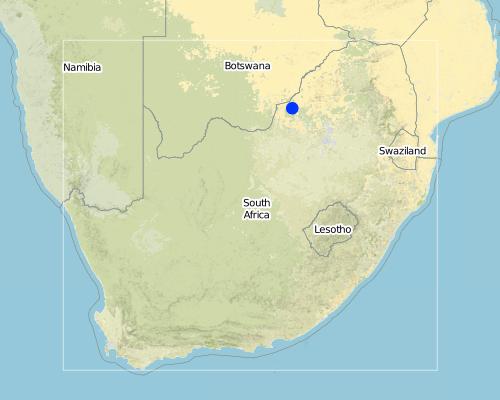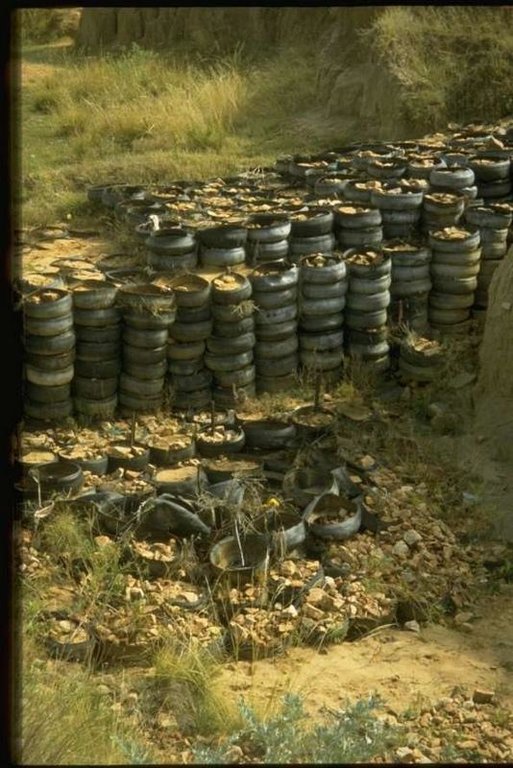Gravity type inverted tyre structure [South Africa]
- Creation:
- Update:
- Compiler: Mirjam Staehli
- Editor: –
- Reviewer: David Streiff
Swaartekrag tipe omgedopte bande struktuur (Afrikaans)
technologies_1374 - South Africa
View sections
Expand all Collapse all1. General information
1.2 Contact details of resource persons and institutions involved in the assessment and documentation of the Technology
Key resource person(s)
SLM specialist:
Du Toit Boeta P.
Marico Bushveld Soil Conservation Committee, South Africa
South Africa
SLM specialist:
Meiring C. H.
Marico Bushveld Soil Conservation Committee, South Africa
South Africa
1.3 Conditions regarding the use of data documented through WOCAT
When were the data compiled (in the field)?
12/12/2003
The compiler and key resource person(s) accept the conditions regarding the use of data documented through WOCAT:
Yes
1.5 Reference to Questionnaire(s) on SLM Approaches
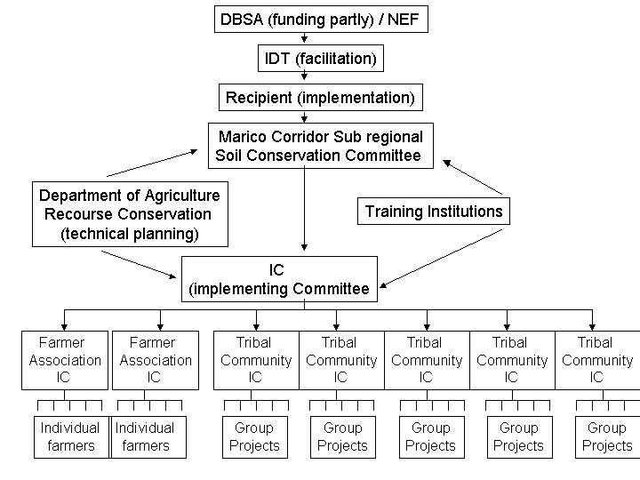
Community driven Protection of the Molatedi Dam Catchment … [South Africa]
Development and capacity building in participating communities through the implementation of measures to prevent topsoil losses through erosion in the Molatedi dam catchment area.
- Compiler: Philippe Zahner
2. Description of the SLM Technology
2.1 Short description of the Technology
Definition of the Technology:
Stabilising of gully erosion by means of gravity type inverted tyre structures filled with stone.
2.2 Detailed description of the Technology
Description:
Gravity type inverted tyre structure is bound together with wire and filled with stone.
The valley floor gully head drop is protected to prevent further erosion. Survey planning and design are important for the construction of the structure.
Maintenance includes prevention of leakage alongside the structure. The walls to prevent the erosion of soil are filled in. Ensure that the top layer stones are not washed away.
The structure is situated in a semi-arid area which is highly degraded through overgrazing.
Due to the location of the structure, further erosion was stopped that would have endangered some of the homesteads.
2.3 Photos of the Technology
2.5 Country/ region/ locations where the Technology has been applied and which are covered by this assessment
Country:
South Africa
Region/ State/ Province:
North West Province
Further specification of location:
Marico District
Map
×2.6 Date of implementation
If precise year is not known, indicate approximate date:
- less than 10 years ago (recently)
2.7 Introduction of the Technology
Specify how the Technology was introduced:
- through projects/ external interventions
Comments (type of project, etc.):
Developed by technician department Resource Conservation and farmer from local conservation committee.
3. Classification of the SLM Technology
3.1 Main purpose(s) of the Technology
- reduce, prevent, restore land degradation
3.2 Current land use type(s) where the Technology is applied

Grazing land
Comments:
Major land use problems (compiler’s opinion): Lack of landuse planning. Overgrazing. Overpopulation.
Major land use problems (land users’ perception): Lack of grazing land, frequent occurrence of droughts.
Constraints of infrastructure network (roads, railways, pipe lines, power lines): Not planning for access roads in the village
3.3 Further information about land use
Number of growing seasons per year:
- 1
Specify:
Longest growing period in days: 240; Longest growing period from month to month: Sep - Apr
3.4 SLM group to which the Technology belongs
- cross-slope measure
3.5 Spread of the Technology
Specify the spread of the Technology:
- evenly spread over an area
If the Technology is evenly spread over an area, indicate approximate area covered:
- 1-10 km2
Comments:
Total area covered by the SLM Technology is 12 km2.
Same technology was also applied in the Molatedi tribal village (70 km away in the same catchment area)
3.6 SLM measures comprising the Technology

structural measures
- S1: Terraces
3.7 Main types of land degradation addressed by the Technology

soil erosion by water
- Wt: loss of topsoil/ surface erosion
- Wg: gully erosion/ gullying
Comments:
Secondary types of degradation addressed: Wt: loss of topsoil / surface erosion
Main causes of degradation: overgrazing, droughts, education, access to knowledge and support services (Lack of knowledge - Lack of training & awareness)
Secondary causes of degradation: over-exploitation of vegetation for domestic use, other human induced causes (specify) (Agricultural causes - Lack of extension and planning), land tenure (Land subdivision - Only if someone own land (commercial farmers)), poverty / wealth (Lack of employment), Lack of enforcement of legislat./authority (Regarding natural resources)
3.8 Prevention, reduction, or restoration of land degradation
Specify the goal of the Technology with regard to land degradation:
- prevent land degradation
- reduce land degradation
Comments:
Secondary goals: prevention of land degradation
4. Technical specifications, implementation activities, inputs, and costs
4.1 Technical drawing of the Technology
4.2 Technical specifications/ explanations of technical drawing
further downstream another tyre construction trapping the silt, behind the structure silting up and vegetation is well growing
North West
Date: April 1999
Technical knowledge required for field staff / advisors: high
Technical knowledge required for land users: moderate
Main technical functions: control of dispersed runoff: impede / retard
Structural measure: Gully head drop structure
Construction material (earth): wire iron posts, plastic material, geotextilemembranes (bidim-kaymat) -water permeable soil exclude
Lateral gradient along the structure: 50%
4.3 General information regarding the calculation of inputs and costs
other/ national currency (specify):
Rand
Indicate exchange rate from USD to local currency (if relevant): 1 USD =:
6.0
Indicate average wage cost of hired labour per day:
1.50
4.5 Costs and inputs needed for establishment
| Specify input | Unit | Quantity | Costs per Unit | Total costs per input | % of costs borne by land users | |
|---|---|---|---|---|---|---|
| Labour | Labour | ha | 1.0 | 9400.0 | 9400.0 | |
| Equipment | Tools | ha | 1.0 | 600.0 | 600.0 | |
| Equipment | Tyre averting tool machine | ha | 1.0 | 100.0 | 100.0 | |
| Construction material | Geotextile membrane | ha | 1.0 | 2000.0 | 2000.0 | |
| Construction material | Wire 2mm (rolls a 50kg) | ha | 1.0 | 330.0 | 330.0 | |
| Construction material | Fully galvanised iron | ha | 1.0 | 50.0 | 50.0 | |
| Total costs for establishment of the Technology | 12480.0 | |||||
Comments:
Duration of establishment phase: 0 month(s)
4.7 Costs and inputs needed for maintenance/ recurrent activities (per year)
Comments:
The complete structure.
4.8 Most important factors affecting the costs
Describe the most determinate factors affecting the costs:
Labour - very low productivity. Transportation of tyres. Tying wire must be cut economically according to need otherwise huge waste take place.
5. Natural and human environment
5.1 Climate
Annual rainfall
- < 250 mm
- 251-500 mm
- 501-750 mm
- 751-1,000 mm
- 1,001-1,500 mm
- 1,501-2,000 mm
- 2,001-3,000 mm
- 3,001-4,000 mm
- > 4,000 mm
Specifications/ comments on rainfall:
Thunderstorms, heavy rainfall
Agro-climatic zone
- semi-arid
Summer rainfall
5.2 Topography
Slopes on average:
- flat (0-2%)
- gentle (3-5%)
- moderate (6-10%)
- rolling (11-15%)
- hilly (16-30%)
- steep (31-60%)
- very steep (>60%)
Landforms:
- plateau/plains
- ridges
- mountain slopes
- hill slopes
- footslopes
- valley floors
Altitudinal zone:
- 0-100 m a.s.l.
- 101-500 m a.s.l.
- 501-1,000 m a.s.l.
- 1,001-1,500 m a.s.l.
- 1,501-2,000 m a.s.l.
- 2,001-2,500 m a.s.l.
- 2,501-3,000 m a.s.l.
- 3,001-4,000 m a.s.l.
- > 4,000 m a.s.l.
Indicate if the Technology is specifically applied in:
- concave situations
Comments and further specifications on topography:
Soil fertility is low
Soil drainage / infiltration is good
Soil water storage capacity is medium
5.3 Soils
Soil depth on average:
- very shallow (0-20 cm)
- shallow (21-50 cm)
- moderately deep (51-80 cm)
- deep (81-120 cm)
- very deep (> 120 cm)
Soil texture (topsoil):
- medium (loamy, silty)
Topsoil organic matter:
- low (<1%)
5.6 Characteristics of land users applying the Technology
Off-farm income:
- > 50% of all income
Relative level of wealth:
- poor
Indicate other relevant characteristics of the land users:
Population density: 100-200 persons/km2
Annual population growth: 3% - 4%
and own 100% of the land (Communal land belongs to the tribe).
Off-farm income specification: State pensions- head of family work elsewhere.
5.8 Land ownership, land use rights, and water use rights
Land ownership:
- communal/ village
Land use rights:
- open access (unorganized)
6. Impacts and concluding statements
6.1 On-site impacts the Technology has shown
Socio-economic impacts
Income and costs
diversity of income sources
Comments/ specify:
short term job creation
Socio-cultural impacts
community institutions
SLM/ land degradation knowledge
Ecological impacts
Soil
soil loss
6.2 Off-site impacts the Technology has shown
downstream flooding
downstream siltation
spending on consumer goods in shops in area
6.4 Cost-benefit analysis
How do the benefits compare with the establishment costs (from land users’ perspective)?
Short-term returns:
neutral/ balanced
Long-term returns:
positive
How do the benefits compare with the maintenance/ recurrent costs (from land users' perspective)?
Short-term returns:
positive
Long-term returns:
positive
6.5 Adoption of the Technology
- 10-50%
If available, quantify (no. of households and/ or area covered):
20 percent of the area
Of all those who have adopted the Technology, how many have did so spontaneously, i.e. without receiving any material incentives/ payments?
- 0-10%
Comments:
100% of land user families have adopted the Technology with external material support
100 land user families have adopted the Technology with external material support
Comments on acceptance with external material support: estimates
There is no trend towards spontaneous adoption of the Technology
6.7 Strengths/ advantages/ opportunities of the Technology
| Strengths/ advantages/ opportunities in the land user’s view |
|---|
| Labour intensive, job creation |
| Received training |
| Strengths/ advantages/ opportunities in the compiler’s or other key resource person’s view |
|---|
| Low cost material |
| Labour intensive can be utilized without machinery |
| Mostly unskilled labour can be used. |
6.8 Weaknesses/ disadvantages/ risks of the Technology and ways of overcoming them
| Weaknesses/ disadvantages/ risks in the land user’s view | How can they be overcome? |
|---|---|
| Storm water walls are in the way of motor vehicles, travelling in the village | Plan roads properly - construct alternative road around wall. |
| Weaknesses/ disadvantages/ risks in the compiler’s or other key resource person’s view | How can they be overcome? |
|---|---|
| Costly if manual labour is unproductive | Maintain high productivity. Train workers, work smart, contract work |
| Transport cost of tyres is a big factor. | Utilize tyres from nearby areas. Utilizes big transport trucks with big loading capacity. |
| Need machine to invert tyres | Tool well and practically constructed - operators trained. |
| Must technically be well planned and constructed. | Use skilled technician for planning and to assist workers during construction. |
Links and modules
Expand all Collapse allLinks

Community driven Protection of the Molatedi Dam Catchment … [South Africa]
Development and capacity building in participating communities through the implementation of measures to prevent topsoil losses through erosion in the Molatedi dam catchment area.
- Compiler: Philippe Zahner
Modules
No modules



